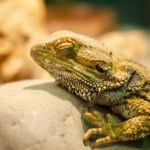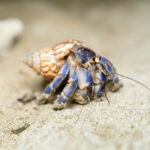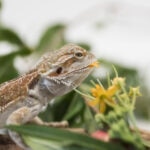Why Do Lizards Do Push-Ups?

Photo by AZ Cat/iStock/Getty Images Plus
With over 7,000 species, lizards live in nearly every temperate habitat worldwide. These lovable reptiles are versatile and surprisingly adaptable, and make great pets. They even have interesting behaviors—like doing push-ups as a form of communication!
While seeing a lizard perched on a rock while their tiny arms pump up and down is cute, you may wonder what exactly they are communicating.
Let’s dive in and learn more about lizard push-ups and why they do them.
What Do Lizard Push-Ups Look Like?
Video by mlharing / Creatas Video via Getty Images
Actually, not all lizards do push-ups. “It’s mostly the territorial species that do [it],” explains Mario Nickerson, co-founder of Nature’s Edge Wildlife and Reptile Rescue in Texas.
However, those who do lower the front of their body to the ground and lift back up again—the same way a human would do a push-up. Sometimes, they bob their heads or even alter the pace of their push-ups.
Faster push-ups can tell other lizards to stay away from their territory, while a slower, relaxed pace might be a simple greeting or, “Hey, I see you watching me.”
Among the pet species, green iguanas and anoles may be best known for their push-up activity, explains Nickerson. Anoles also have a colorful throat pouch, called a dewlap, that flexes while they’re doing push-ups.
Why Lizards Do Push-Ups
“Lizards do push-ups for two main reasons: either because of a threat or a mating ritual,” says Mark Pyle, reptile educator and former president of the DFW Herpetological Society.
In the same way that some animals let predators know they’ve been seen, lizards may be doing the same thing, says Pyle. “They’ll even do push-ups as a threat display for people,” he adds.
Pyle explains that lizards want to look as big and impressive as possible because it helps avoid confrontations, it can give them time to escape a predator, and it shows females that they’re strong and healthy.
Still, even though you may not know why a lizard is doing push-ups, the lizards know! Even subtle differences can communicate different messages.
Some species also add colorful accents during mating season. They adjust their body to show off their seasonal colors while they do push-ups, they make other motions to attract a mate.
Territorial Communication
While many lizards can make some sounds and use vocalizations to communicate, vocalizations aren’t always important to their communication.
Instead, they use body language like push-ups, head bobs, or arm waves. Territorial displays are common among lizard species, including pets like anoles, bearded dragons, and geckos.
“Sometimes you’ll see a lizard in the distance that’s doing push-ups,” Pyle explains. “Wherever he’s looking, look there too—there’s probably a lizard sitting right over there.”
Male lizards use push-ups to intimidate other males—in doing so, they carve out a large territory where several females live. If another lizard ignores their push-ups, that polite conversation can escalate to head bobbing, more aggressive posturing, and sometimes a full-on fight.
Females also carve out territory and defend it from other lizards so they can have a safe area to lay their eggs. However, it’s usually a smaller chunk of land than the males defend.
Mating Behavior
When it comes to finding a mate, strength and health matter. To get the best chance at finding and attracting a mate, the males work hard to attract females.
But it isn’t only the males communicating mating interest with push-ups; a female will sometimes do push-ups to let nearby males know she’s looking for a mate. In some species, the faster and stronger a lizard’s push-ups are, the more impressive they look.
Lizard mating rituals can be complex, with males and females participating in a variety of dance movements. Some include head bobs, waves, and puffing out dewlaps—they’re showing off their strength, good health, and even genetics.
Push-Ups with a Purpose
Although lizards look like they’re working out, their push-ups have a purpose. Whether they’re trying to attract a mate, defending their territory, or warning potential threats, push-ups and other body language form a vital part of their communication.
Each type of lizard has their own style, speed, and reason for doing push-ups, making the behavior as unique is it is fascinating.
So the next time you spot a lizard doing push-ups, remember—it’s not just exercise; it’s language without words. Take a moment to appreciate this exceptional behavior and what the lizard might be trying to say.
This content was medically reviewed by Melissa Witherell, DVM, Chewy veterinarian.



